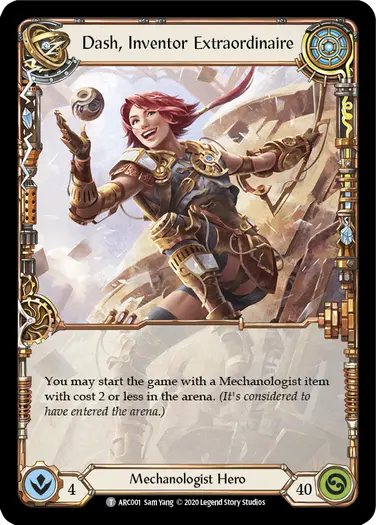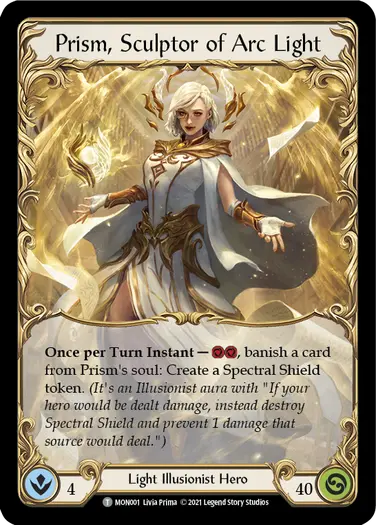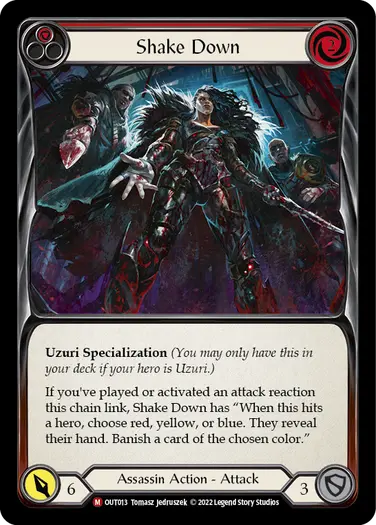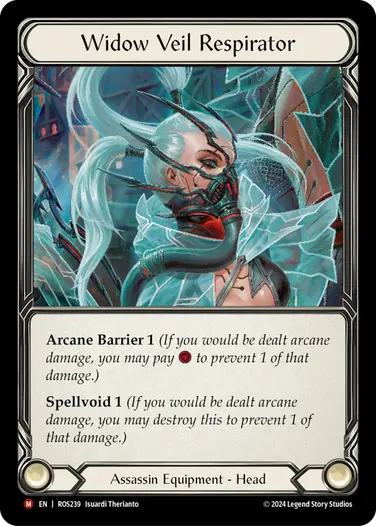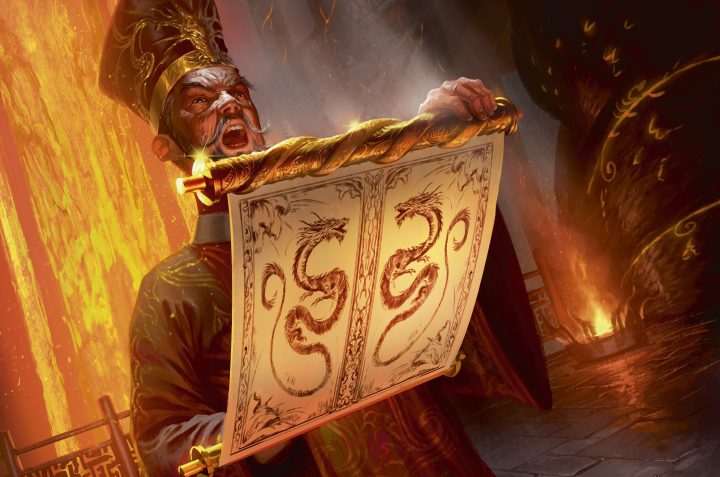Play like a boss with Primed to Fight, where we reel in pro players to share their expertise on various aspects of competitive Flesh and Blood! Today we have Elly Bird, Calling Top 8 finisher, Pro Quest winner, Boltyn enthusiast, and recent live stream casting breakout superstar. Elly is here ahead of Pro Quest: Europe to deepen your knowledge of Classic Constructed by breaking down the difference between a "value" gameplan and a "macro" gameplan, and how different heroes approach victory.
With a new set released comes a new metagame, and with the first few competitive events coming to a close, a field has started to develop. Made of an eclectic mix of holdovers from the previous set, all-new heroes, and some classic champions injected with a little bit of Rosetta-style love and support, some strong contenders are looking to claim the title of “best deck in the format”.
At Calling: Lyon, we saw a massive turnout from Enigma, taking up 4 of the Top 8 slots there, as well as Pablo Pintor taking the event down on that exact hero! A Battle Hardened the same weekend was won by none other than Nick Gabler on Viserai, and just a week before, a Pro Quest+ event was defined by a breakout performance from Michael Ramsey on Aurora, with some notable success as well from Florian and Verdance, piloted by Yuki Lee Bender and Evan Ford respectively.
The top decks comprising the early metagame are clear, but where will the rogue decks arise? What champions will look to prey upon these dominant contenders? Most importantly, will you choose to sleeve up a dominant option, or find a path to victory with an unexpected angle into the metagame? Each and every one of these decks we’re seeing now falls into one of two categories, or somewhere in between – a deck with a "value" gameplan, or a deck with a "macro" gameplan, and it’s time to shine some light on exactly what those two archetypes mean, just what forces they exert on a new metagame, as well as how to identify a rogue deck’s niche.

What is a "value" gameplan?
Value decks aim to close out games by, via their turn-to-turn gameplay, extracting greater numbers from their cards than their opponent is capable of mustering – meaning the turn will focus on whatever sequencing generates the most ‘points’ from a given hand.
A classic example of this concept is red Wounding Blow! This is a card that, if blocked with, is worth 3 points of life. However, it generates 4 points of life if you choose to attack with it. Assessing every card in a vacuum is easy, but the approach to winning games like this involves a bit more texture, with value-oriented heroes finding themselves having to assess the total attack and defense value of each 4-card hand.
For example, given the choice between Enlightened Strike for 5 with go again, then a Fyendal’s Fighting Spirit for 7, or defending for 6, and just attacking for 7, these decks will almost always choose the latter option, as 13 is greater than 12.
Through the 5 years we’ve been here, many of Flesh and Blood’s classic dominant contenders have used this framework to crush tournaments from the early days of “Ninja Turtle” Katsu, to more modern success stories like Kayo. It stands to reason that heroes capable of generating abundant or efficient numbers through their ability and/or card pool will pull ahead of their peers in this arithmetic race. Even outliers in the power level space are bound to this logic.
A massive part of two of Flesh and Blood’s most infamous heroes' success, “Starvo”, and Zen is owed to their abilities generating significant numbers advantage. Be it Starvo’s more direct approach of getting bonus attack power and action points for lining up his hands correctly, or a more abstract numerical edge like Zen using Crouching Tigers as additional cards to work with, numbers were the name of the game when it came to these titans of the format putting down their enemies.
What is a "macro" gameplan?
Value is far from the only way to play Flesh and Blood, and lurking in the shadows of a game where turns are often by defined by math problems are heroes dropping this approach entirely to focus on gameplay ignoring numbers, and getting edges by interacting with the game’s core systems in an entirely different way!
A prime example is the control build of Dash, with her goal to set up items until her Teklo Plasma Pistol becomes impossible to deal with. Decks like this are often defined by having a "macro" gameplan, executed over the course of the entire game to great effect, without as much emphasis on value edges.
While metagames are typically lead by the highest value decks pulling ahead early and becoming the decks to beat, macro decks find footing as "rogue" decks, carving out a niche in spite of lower value turn cycles because their goal lines up well into what’s currently defining the format. Starvo and Zen, despite their overwhelming efficiency, often found themselves preyed upon by then-rogue decks of the format, using their tools to stifle these big value players.
Prism and Lexi both took dramatically different approaches to smothering Starvo’s overwhelming assault. Prism established a board of many permanents and weathered the storm while her auras, despite being lower-value plays when they come down, created an unsolvable problem for the Elemental Guardian. In an entirely different vein, Lexi used cards capable of making the opponent discard cards, making it impossible to use his hero ability which often required larger hands – which let her keep up the pressure despite generally lower attack values.
Another example as recent as Pro Tour: Amsterdam, Zen’s macro predators often reduced the cards available to the Mystic Ninja, denying him the ability to leverage his hero ability and powerful multipliers like Art Of War. Uzuri and Nuu favored ripping cards out of his hand with lower power attacks with punishing on-hit effects to prevent him from mounting enough of an offense to close the game.
Nearly the polar opposite of value decks, macro decks are born into relevance by the tools available to them allowing for varied options of nonstandard gameplay and win conditions. This, of course, isn’t necessarily to say that all macro decks are rogue decks. Nor are all value-oriented strategies instant champions of the meta, so much as these are the roles decks like this often find themselves developing into.
The Here and Now
The current meta is clearly being shaped by some frontrunners that split themselves up neatly among these categories we’ve just established.
Aurora is an archetypical value deck, looking to maximize her point value in any given hand, typically on the offensive, and crush her opponents under some massive pressure. She also touts a hallmark trait of the Runeblade class – damage split between arcane and physical, making it more difficult to stem the bleeding.
Enigma is a very classic macro deck, looking to establish and protect a board of ward auras that both attack and defend. If left alone, she’s capable of smothering you in on-board threats that ramp up over time.
Florian shows us shades of both, winning games with number advantages but being forced to feed up a healthy banished zone over the course of the game to get that extra value kick. He’ll shoot for efficiency early as he gets his decomposing done, but when the time comes, his numbers become overwhelming.
As these three major forces push and pull on the development of the format, they make demands of rogue decks to be viable. Heroes like Enigma and Florian require you to have a powerful proactive gameplan in order to prevent them from executing their long-term strategy, while heroes like Aurora and Viserai put you on a clock, pressuring you with efficient damage that’s difficult to interact with.
Azalea is a prime contender for this role, capable of presenting massive arrows that both dish out punishing amounts of damage, while also tossing your plans for your own turn aside with powerful disruption like Red in the Ledger.
Levia is a Brute much like Kayo, capable of leveraging Bloodrush Bellow and powerful 6-power disruption like Command and Conquer to slow her adversaries down as she attempts to drown them in damage numbers. She’s also found a breath of new life with Rosetta’s Call to the Grave allowing for some incredibly flexible and interesting deckbuilding options.
As far as macro options go, Mister “the Hype” Nitro himself, Maxx has plenty of game into current meta forces as both an efficient aggressive deck, as well as a full combo style deck when he chooses to play Nitro Mechanoid! He’ll also be receiving some new gas for the tank with Armory Deck: Dash in the form of equipment and Fast and Furious lending more consistency to his Hyper Drivers.
Lastly, Prism is far from out of the game after the recent banning of Tome of Divinity. The Awakener of Sol has found new relevancy with her ability to leverage Figment of Judgment and its angel counterpart's abilities to turn earth cards in the banished zone face down, undoing Florian’s hard work.
Whatever tools you bring, picking a rogue deck for this Pro Quest season is a matter of assessing what decks you expect to see in your local metagame, as well as identifying a particular strategy that may stand above others as effective into common choices!
A core tenet of choosing to bring a rogue deck is accepting that you may only be targeting some amount of the metagame and sacrificing equity in other places. Uzuri, the victor of Pro Tour: Amsterdam, also nearly entirely sacrificed her matchup into Enigma, and blew the tournament out of the water as a hero nobody expected to be there.
Similarly, we’ve seen the rise of another Rosetta tool, Count your Blessings, as a rogue deck macro package being used to smother midrange decks by slotting in an overwhelming amount of long-term life gain for matchups that don't output enough pressure. As fantastic as it is at that role, these Count Your Blessings decks find themselves incapable of beating heroes in other places on the spectrum, especially struggling into Enigma.
The Assassins have not only gotten some new arcane protection with the "Widow" equipment set, but also remain fantastic choices into many decks looking to keep specific cards or larger hands. If your opponents love defending, Kano may be the choice for you! Rogue decks oft reward specialization and dedication, allowing skilled masters of any given hero to find their moment and blow through a competitive season with ease.
With a greater understanding of how metagames develop and what demands certain strategies make of your deck, I look forward to seeing everyone crush their local Pro Quests on Boltyn, Fai, Teklovossen, or whatever other meta outlier you see fit. As this new metagame gets a bit longer in the tooth, I can’t wait to see what becomes the new dominant force, or perhaps in just a month, the new World Championship winning deck!






